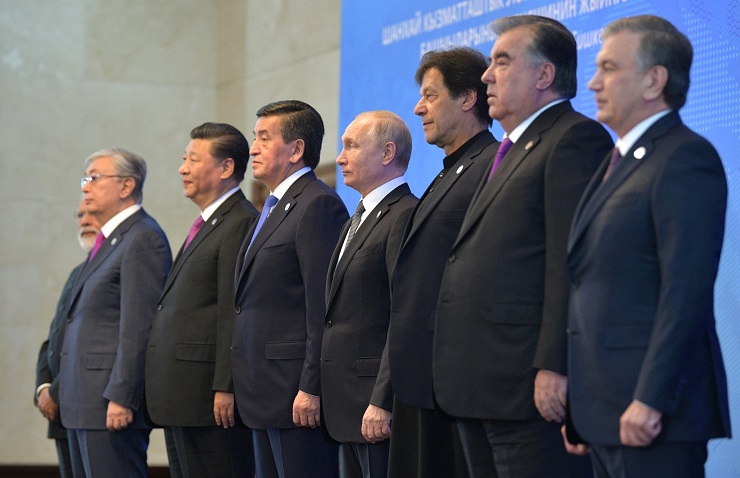For decades, especially since the end of the Cold War, the US has been paying special attention to Central Asia, the so-called ‘underbelly’ of Russia. It was able to establish its military bases and penetrate the CAS through its various aid programs. Since the 1990s, a primary US interest has been to build a Central Asia that is politically and economically tied with the West. This was the intention when the Obama administration launched C5+1 joint project in 2015. The project was aimed at pumping US money into the CAS to allow for greater US manipulation of the region against Russia and China. This, however, has significantly changed over the past few years due to a combination of factors, including an increasing Russian resurgence and the CAS’ increasingly close economic and security ties with China. While Russian largely remains a dominant player, the recent years have seen the Shanghai Cooperation Organization (SCO) playing an active role. It has been able to develop a security infrastructure that leaves minimum room for external powers to establish their stranglehold.
This is evident from a recently published report of US-China Economic and Security Review Commission. The Commission is headquartered in Washington, DC, and is a congressional commission of the US government. It was created in October 2000 with a mandate to review and report on the national security implications of the bilateral trade and economic relationship between the US and China.
Its most recent report details show increasing Chinese activity in the region has shrunk space for the US to implement its projects. The report mentions,
“Beijing has used the SCO to build its capacity to project military force into Central Asia. Through diplomatic agreements with member countries, the Chinese government has been able to use the SCO to build a foundation for growing its power projection capabilities, with implications not only for a future crisis in Central Asia but also for conflicts in other regions. Central Asia’s proximity to China and the generally favorable views of Central Asian governments toward Beijing have made the region an ideal testing ground for China to practice carrying out counterterrorism as well as other more conventional military operations beyond its borders.”
The Commission sees in this build up significant implications for the future of US policies and projects. It mentions,
“…there is significant risk that Beijing may be able to leverage its relationships with SCO countries to limit the ability of U.S. armed forces to operate in Central Asia. At its 2005 summit, the SCO issued a statement calling for a timeline for the withdrawal of U.S. forces from bases in Uzbekistan and Kyrgyzstan. Pressure from China and Russia likely contributed to Uzbekistan’s decision later that year to evict the United States from Karshi-Khanabad Air Base, which the United States used to support operations in Afghanistan.”
This trend, the report mentions, is likely to accelerate in the wake of US withdrawal from Afghanistan—a process that will inevitably eclipse the US and allow China to spread its influence. A US military exit from the region is the reason why CAS-China joint military exercises have become popular and acceptable.
On the one hand, these exercises have allowed the CA states to wean themselves away from the US, and on the other hand, it has enabled China to “extend its defensive perimeter into Central Asia.”
As it stands, Beijing is closing in on US withdrawal from Afghanistan and is already sitting on the Afghan border. Although Beijing’s interests don’t involve an “occupation” of Afghanistan, it does have vital counter-terrorism interests. “Since 2016, the People’s Armed Police, part of China’s armed forces, has operated an outpost in Tajikistan near that country’s borders with China and Afghanistan”, says the report, to prevent infiltration of terrorists from Afghanistan into the CAS and China mainland.
Failure of the 2020-US Central Asia Strategy
The US withdrawal from Afghanistan and eviction from the CAS indicate a massive failure of the 2020-US Central Asia Strategy announced in February 2020 by the Trump administration.
When the strategy was announced, the US Govt. argued that the strategy was a response to the growing desire of the CAS states to have a “counterweight” to China.
The report of the Commission, however, shows that not only is there no such desire, but that the prospects of an extended and deep US engagement, idealized through the latest strategy, are not realizable too. For one thing, as the report shows, China is a lot more acceptable to the CAS than the US.
Secondly, the fact that China has been able to out-do the US in the CAS is due largely to its concerted strategy of improving relations with Russia as well. The US, on the other hand, has not been able to normalise its relations with Russia—something that not only limits its options, but also pits it against Russia; for, the cardinal purpose of US strategy in the CAS remains direct military presence and political influence.
The intention of the US strategy was also to integrate the CAS with Afghanistan, an objective that has become largely unrealizable due to the Trump administration’s withdrawal from Afghanistan. While the Biden administration may take Afghanistan back to the square one, this will have little to no impact on the US plans for the CAS. The CAS, as it stands, has drifted away from the US despite the latter’s decades long military presence.
Salman Rafi Sheikh, research-analyst of International Relations and Pakistan’s foreign and domestic affairs, exclusively for the online magazine “New Eastern Outlook”.

